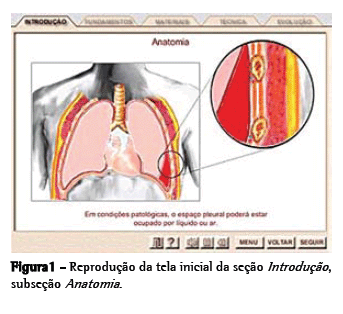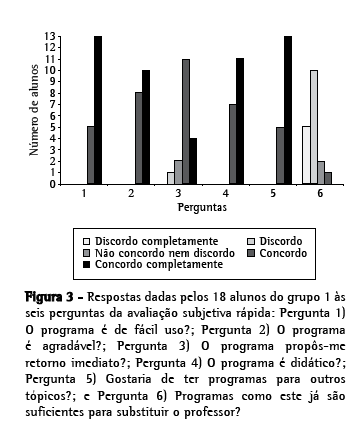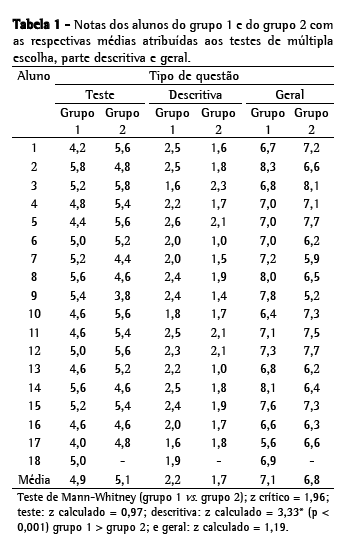



João Aléssio Juliano Perfeito, Vicente Forte, Roseli Giudici, José Ernesto Succi, Jae Min Lee, Daniel Sigulem
ABSTRACT
Objective: To develop a multimedia educational computer program designed to teach pleural drainage techniques to health professionals, as well as to evaluate its efficacy. Methods: We planned and developed a program, which was evaluated by 35 medical students, randomized into two groups. Group 1 comprised 18 students who studied using the program, and group 2 comprised 17 students who attended a traditional theoretical class given by an experienced teacher. Group 1 students were submitted to two subjective evaluations using questionnaires, and both groups took an objective theoretical test with multiple-choice questions and descriptive questions. The results of the theoretical test were compared using the Mann-Whitney test. Results: The subjective evaluation of the technological aspects and content of the program ranged from excellent to very good and good. The software was considered highly instructive by 16 students (88.9%), and 17 students (94.4%) thought it might partially substitute for traditional classes. Between the two groups, there was no significant difference in the multiple-choice test results, although there was such a difference in the descriptive question results (p < 0.001), group 1 students scoring higher than did those in group 2. Conclusions: The computer program developed at the Federal University of São Paulo Paulista School of Medicine proved to be a feasible means of teaching pleural drainage techniques. The subjective evaluation of this new teaching method revealed a high level of student satisfaction, and the objective evaluation showed that the program was as efficacious as is traditional instruction.
Keywords: Teaching; Thoracic surgery; Multimedia; Drainage; Pleural diseases.
RESUMO
Objetivo: Desenvolver um programa educacional de computador sobre drenagem pleural voltado a profissionais de saúde, com recursos de multimídia, e avaliar sua eficácia com alunos. Métodos: Foi planejado o desenvolvimento do programa e a avaliação foi realizada com 35 alunos do curso de medicina divididos aleatoriamente em dois grupos. O grupo 1, composto por 18 alunos, estudou com o programa e o grupo 2, com 17 alunos, recebeu uma aula teórica tradicional, com professor experiente. Os alunos do grupo 1 foram submetidos a duas avaliações subjetivas por questionários, e os alunos de ambos os grupos foram submetidos a uma prova teórica objetiva com testes de múltipla escolha e questões descritivas. Os resultados da prova teórica foram comparados por meio do teste de Mann-Whitney. Resultados: A avaliação subjetiva quanto aos aspectos de informática e conteúdo mostrou resultados entre ótimo, muito bom e bom. O programa foi considerado totalmente didático por 16 alunos (88,9%) e 17 alunos (94,4%) responderam que pode vir a substituir parcialmente as aulas tradicionais. Não houve diferença significante entre os dois grupos nos testes de múltipla escolha, mas houve diferença significante nas questões descritivas (p < 0,001). O grupo 1 obteve notas maiores que as do grupo 2. Conclusões: O desenvolvimento do programa de computador para ensino de drenagem pleural na Universidade Federal de São Paulo/Escola Paulista de Medicina mostrou-se factível. A avaliação subjetiva deste novo método de ensino mostrou-se altamente satisfatória e a avaliação objetiva mostrou que o programa foi tão eficaz quanto o ensino tradicional.
Palavras-chave: Ensino; Cirurgia torácica; Multimídia; Drenagem; Doenças pleurais.
Introdução



